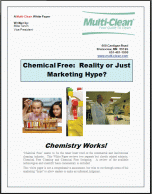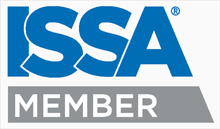White Paper: Chemical Free: Reality of Just Marketing Hype
Visit www.multi-clean.com/training.html to view this and other white papers.
At the recent ISSA show, attendees were subjected to numerous exhibitors marketing Chemical Free Cleaning Technologies. Apparently these companies weren’t told that ISSA Distributor attendees make a substantial amount of their sales and the largest amount of profit off the sale of cleaning chemicals.
Industry consultant, Bill Griffin had an interesting column in the latest issue of Cleaning Management Magazine titled Seeing the Future about trends in the cleaning industry.
The quote from Mr. Griffin that caught my eye from the article was this:
I also see more true science coming to the cleaning industry. What we are getting now is what I call marketing research: it’s not necessarily fact based and is often filtered or screened to promote a specific product or process.
AMEN! I believe a little bit of science and a whole lot of marketing is going on here. We prefer to look at the science.
You can read the whole article in Cleaning Management Magazine http://www.cmmagazine-digital.com/201110#&pageSet=8
Below is a quick review of the Chemical Free systems seen at ISSA. We have also published several White Papers on the subject that attempts to look at the science behind these technologies.
Chemical Free Stripping
This is a misnomer, because you can’t really strip a resilient floor bare due to the highs and lows inherent in these types of floors. This process is essentially a sanding process using aggressive abrasives. The concern here is abrading the VCT tile itself, making it more porous overtime.
The value of a process like this is the removal of dirt laden top coats before applying new coats, sort of a super aggressive top scrub and recoat process. This process can dramatically extend the strip finish cycle.
A less aggressive process that removed 2 coats would provide similar preparation results in the recoating situation. Further, taking off more than is needed is wasteful requiring more subsequent coats of finish to get the desired results.
Electrolyzed Water
The process of passing current between two electrodes immersed in water and a dissolved electrolyte (salt or sodium chloride being the most common) is well understood. Collection of two separate solutions can be achieved, one being an acidic bleach (hypochlorous acid), the other a mild alkaline (sodium hydroxide). This is the basis for the Tennant’s Orbio sc-5000 system. The problem, bleach doesn’t clean and its sanitizing ability is quickly inactivated by organic soil. A mild solution of sodium hydroxide is hardly a cleaning agent in and of itself.
The Tennant ecH2o and ActiveIon system suffer from a similar fate above. However in this case, the claim is made that the acidic bleach and hydroxide ions peacefully coexist in solution after exiting their device to make an effective cleaner for 45 seconds. After 45 seconds, it re-converts to normal water. It seems unlikely that this is possible, but perhaps Tennant has the scientific data to back up this claim.
Ozone
The ability of ozone to sanitize and deodorize is well known. Now, some companies are making the leap that ozone dissolved in water is an effective cleaner. We do not believe this to be true, as like the other technologies above, ozone does have some value, but a powerful cleaning agent it is not.
Heat / Steam
Hot water and/or steam can definitely kill bacteria. Using steam to clean has some merit, and several companies have introduced cleaning devices. But just subjecting dirt to steam is not cleaning, because it does not remove the contamination. Using this process almost certainly requires the soils loosened by the steam must not be vacuumed or somehow physically removed.
 Multi-Clean White Paper: Click on the titles below to view:
Multi-Clean White Paper: Click on the titles below to view:
Chemical Free: Reality or Marketing Hype? CLICK HERE
Chemical Free Stripping: Fact or Fantasy? CLICK HERE

